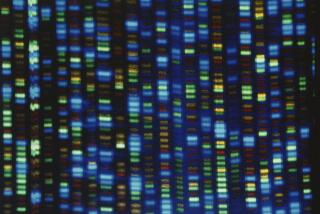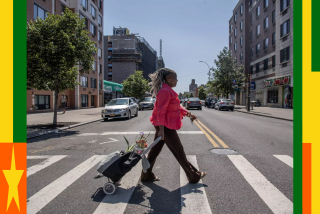Science Gets to Roots of Youths’ Family Trees
For Asha Jordan, questions about who she is and where she comes from always have been hard to answer. The 12-year-old from Baldwin Hills knew that most of her family came generations ago from Africa -- but not much else.
Over the last six weeks, Asha and a group of other students have been spending their Saturdays in an auditorium of the View Park Preparatory Accelerated Charter School, trying to trace their heritages.
In a class called “Black History for Young People,” she has learned about the place of Africans in world history, the massive diaspora brought on by the slave trade, the American civil rights movement and even the roots of hip-hop and rap.
But everything became a lot more personal Saturday morning when, along with 14 other students in the class, Asha got the results of a DNA test.
She had swabbed the insides of her cheeks, labeled the cotton swab with a bar code, and shipped it off to Washington, D.C., where officials at African Ancestry Inc. conducted a sequencing of her mitochondrial DNA. (Inherited from one’s mother, such DNA undergoes little change through time and is useful in constructing an evolutionary tree.)
They then compared her results with the company’s DNA database, which includes samples from about 25,000 indigenous Africans representing 300 ethnic groups in 30 countries.
African Ancestry’s president, Gina Paige, said it is often important to African Americans -- many of whom had ancestors who were torn from their home countries by the slave trade -- to learn where they came from.
“Even though they took our name, even though they took our language, even though they took us from our homes, they didn’t take our DNA,” Paige told the students. “The one thing we had was that DNA, passed from our great-great-great-grandmothers down to us.”
Before she revealed the students’ results, Paige gave the students a mini course in DNA science: how sequencing is done and why she had tested students’ mitochondrial DNA.
“You are creating your own identity,” Paige said. “What we are giving you is one piece of who you are.”
As Asha stood in front of the class, awaiting her results, she looked a bit nervous. She shifted from side to side.
“Are you ready?” Paige asked her.
Asha just smiled.
The answer, for Asha at least, was complex. She shares genetic traits with three ethnic groups in Cameroon and with the Bubi people of Bioko Island, off the coast of Equatorial Guinea. Still, she said, “I really felt like I belonged somewhere. I was emotional. My mom was emotional.”
Professor Kwaku Person-Lynn, who spent part of his summer vacation from Loyola Marymount University leading the history class, found that his ancestors came from what today are the countries of Senegal, Sierra Leone and Liberia.
Other students found that their ancestors had come from Nigeria, Ghana, Guinea-Bissau and other places.
“I know more about where I came from than what I learned in school [during the regular school year],” said Cydnee Charles, 17, of Los Angeles.
Asha’s mother, Apryl Sims-Jordan, said the class exercises represented an opportunity of sorts for a people torn apart long ago by slavery. “You can let go of bitterness, resentment,” she said. “It’s very, very healing.”
More to Read
Sign up for Essential California
The most important California stories and recommendations in your inbox every morning.
You may occasionally receive promotional content from the Los Angeles Times.










